Third Term PHE Lesson Note for Primary 3 – Lesson Notes
ACCESS ALL LESSON NOTES
ACCESS ALL QUESTIONS AND ANSWERS
ACCESS ALL WORKSHEETS
ACCESS ALL JOBS ACCESS
ACCESS WAEC QUESTIONS AND ANSWERS
WEEK 1
Topic: System of the body and it’s functions
Learning Objectives:At the end of this this lesson,pupils should be able to:
1. say the meaning of the system of the body.
2. list the system of the body.
3. draw and label the respiratory and circulatory systems.
4. explains the functions of the respiratory and circulatory system
Resources and materials:
Scheme of work
Online information
Instructional material:
1. Diagrams
2. Posters
3. Charts
4. Pictures
5. Chalkboard.
Building Background/connection to prior knowledge: pupils are familiar with the topic in their previous classes.
CONTENT
Body Systems Definition
Body systems are groups of organs and tissues that work together to perform important jobs for the body. Some organs may be part of more than one body system if they serve more than one function. Other organs and tissues serve a purpose in only one body system.
1. Respiratory System
Allows gas exchange between cells and the environment. Includes trachea and lungs.The respiratory system brings air into the body and removes carbon dioxide. It includes the nose, trachea, and lungs. When you breathe in, air enters your nose or mouth and goes down a long tube called the trachea. The trachea branches into two bronchial tubes, or primary bronchi, which go to the lungs
2. Digestive System/Excretory System
Ingests food and breaks it down into usable nutrients. Excretes solid waste products. Includes the mouth, esophagus, stomach, and intestines
– 3. Cardiovascular/Circulatory System
Moves materials between body systems, including oxygen, nutrients, hormones, and waste products. Includes the heart, arteries, and veins.
4. Muscular system
The muscular system is made up of tissues that work with the skeletal system to control movement of the body. Some muscles—like the ones in your arms and legs—are voluntary, meaning that you decide when to move them. Other muscles, like the ones in your stomach, heart, intestines and other organs, are involuntary.
5. Skeletal system
Allows the body to move on command. The skeletal system is made up of bones, ligaments and tendons. It shapes the body and protects organs. The skeletal system works with the muscular system to help the body move. Marrow, which is soft, fatty tissue that produces red blood cells, many white blood cells, and other immune system cells, is found inside bones
FUNCTIONS OF CIRCULATORY SYSTEM
Circulatory system:
1.Circulates blood around the body via the heart, arteries and veins, delivering oxygen and nutrients to organs and cells and carrying their waste products away.
2. Keeps the body’s temperature in a safe range.
FUNCTIONS OF THE RESPIRATORY SYSTEM
Brings air into and out of the lungs to absorb oxygen and remove carbon dioxide.
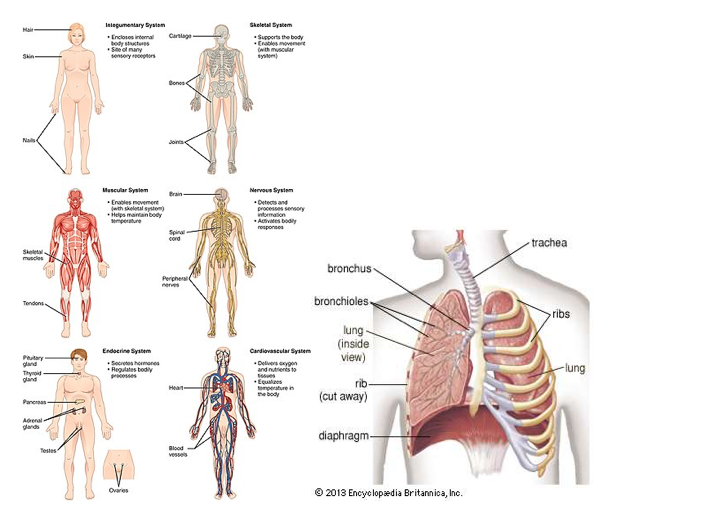
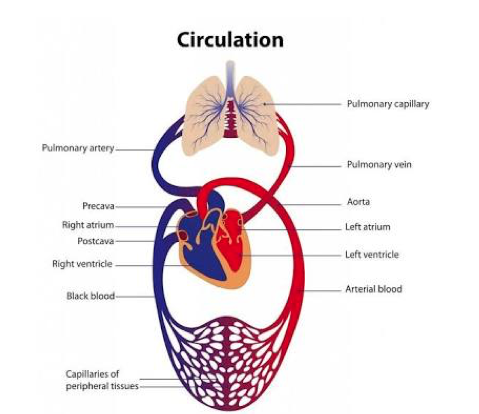
Strategies& Activities:
Step :Teacher revises the previous topic.
Step 2:Teacher introduces the new topic.
Step3:Teacher explains the new topic.
Step4: Teacher welcomes pupils questions.
Step5: Teacher evaluates the pupils.
Assessment & Evaluation:
1. say the meaning of the system of the body.
2. list the system of the body.
3. draw and label the respiratory and circulatory systems.
4. explains the functions of the respiratory and circulatory system
WRAP UP(CONCLUSION) Teacher goes over the topic once again for better understanding.
Assignment:
1. explains the meaning of the system of the body.
2. name five systems of the body.
3. explains the respiratory of the body.
4. draw the circulatory system and label
5. list three functions each of respiratory and circulatory system of the body.
WEEK 2
Topic: System of the body and it’s functions
SUBTOPIC: Digestive system
Learning Objectives:At the end of this this lesson,pupils should be able to:
1. say the meaning of digestive system
2. list the parts of the digestive system
3. draw and label the digestive system
4. explains the functions of the digestive system
Resources and materials:
Scheme of work
Online information
Instructional material:
1. Diagrams
2. Posters
3. Charts
4. Pictures
5. Chalkboard.
Building Background/connection to prior knowledge: pupils are familiar with the topic in their previous classes.
CONTENT
DIGESTIVE SYSTEM
The human digestive system is a series of organs that converts food into essential nutrients that are absorbed into the body. The digestive organs also move waste material out of the body.
The enzymes in saliva help break down foods, and the lubrication function of saliva makes it easier for food to be swallowed.
PARTS OF THE DIGESTIVE SYSTEM
Stomach
Small intestine
Pancreas
Liver
Gallbladder
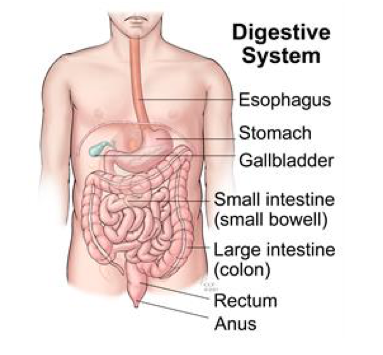
Colon (large intestine)
Rectum
Anus
FUNCTIONS OF THE DIGESTIVE SYSTEM
The function of the digestive system is to break down the foods you eat, release their nutrients, and absorb those nutrients into the body
Diagram of the digestive system

Strategies& Activities:
Step :Teacher revises the previous topic.
Step 2:Teacher introduces the new topic.
Step3:Teacher explains the new topic.
Step4: Teacher welcomes pupils questions.
Step5: Teacher evaluates the pupils.
Assessment & Evaluation:
.1. say the meaning of digestive system
2. list the parts of the digestive system
3. draw and label the digestive system
4. explains the functions of the digestive system
WRAP UP(CONCLUSION) Teacher goes over the topic once again for better understanding.
Assignment:
1. Define digestive system
2. list 5 parts of the digestive system
3. draw and label the digestive system
4. explains the functions of the digestive system
.
WEEK3
Topic: System of the body and it’s functions
SUBTOPIC: Muscular system
Learning Objectives:At the end of this this lesson,pupils should be able to:
1. say the meaning of muscular system
2. list the parts of the muscular system
3. draw and label the muscular system
4. explains the functions of the muscular system
Resources and materials:
Scheme of work
Online information
Instructional material:
1. Diagrams
2. Posters
3. Charts
4. Pictures
5. Chalkboard.
Building Background/connection to prior knowledge: pupils are familiar with the topic in their previous classes.
CONTENT
MUSCULAR SYSTEM
The muscular system is made up of tissues that work with the skeletal system to control movement of the body. Some muscles—like the ones in your arms and legs—are voluntary, meaning that you decide when to move them. Other muscles, like the ones in your stomach, heart, intestines and other organs, are involuntary.
Functions of skeletal muscle
Skeletal muscle has four major functions, these are:
· Mobility
· Posture
· Stability
· Respiration
· Circulation
· Digestion
· Urination
· Vision
· Child birth
· Organ protection
· Temperature regulator
DIAGRAM OF MUSCULAR SYSTEM
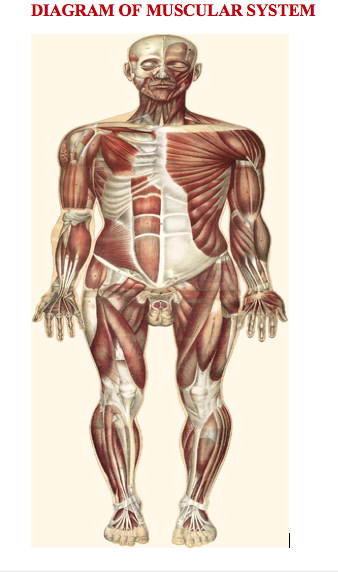
Strategies& Activities:
Step :Teacher revises the previous topic.
Step 2:Teacher introduces the new topic.
Step3:Teacher explains the new topic.
Step4: Teacher welcomes pupils questions.
Step5: Teacher evaluates the pupils.
Assessment & Evaluation:
1. say the meaning of muscular system
2. list the parts of the muscular system
3. draw and label the muscular system
4. explains the functions of the muscular system
WRAP UP(CONCLUSION) Teacher goes over the topic once again for better understanding.
Assignment:
1. Define muscular system
2. list the parts of the muscular system
3. draw and label the muscular system
4. explains the functions of the muscular system
WEEK 4
Topic: System of the body and it’s functions
SUBTOPIC: Skeletal system
Learning Objectives:At the end of this this lesson,pupils should be able to:
1. say the meaning of skeletal system
2. draw and label the skeletal system
3. explains the functions of the skeletal system
Resources and materials:
Scheme of work
Online information
Instructional material:
1. Diagrams
2. Posters
3. Charts
4. Pictures
5. Chalkboard.
Building Background/connection to prior knowledge: pupils are familiar with the topic in their previous classes.
CONTENT
THE SKELETAL SYSTEM
The skeleton is the body part that forms the supporting structure of an organism. It can also be seen as the bony frame work of the body which provides support, shape and protection to the soft tissues and delicate organs in animals
FUNCTIONS OF THE SKELETAL SYSTEM
skeletal system has several additional functions, including:
1.Protecting internal organs from injury. For example, the skull protects the brain, while the thoracic cage protects the heart and lungs.
2.Allowing for movement. Muscles attach to bones through tendons. This connection allows the body to move in many different ways.
3. Producing blood cells. The soft bone marrow inside of many bones produces red blood cells, white blood cells, and platelets.
4. Storing minerals and nutrients. Bones can store and release minerals, including calcium and phosphorus, which are important for many bodily functions. Additionally, adipose (fat) tissue that can be used as energy can be found in part of the bone marrow..
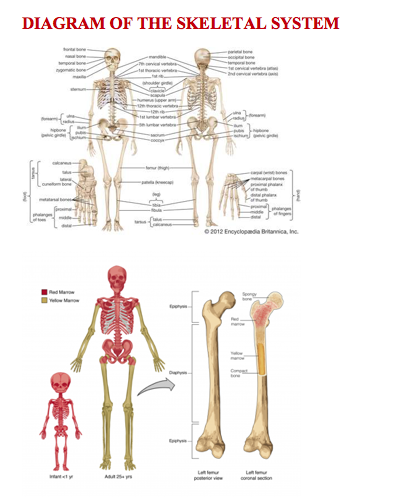
Strategies& Activities:
Step :Teacher revises the previous topic.
Step 2:Teacher introduces the new topic.
Step3:Teacher explains the new topic.
Step4: Teacher welcomes pupils questions.
Step5: Teacher evaluates the pupils.
Assessment & Evaluation:
1. say the meaning of skeletal system
2. draw and label the skeletal system
3. explains the functions of the skeletal system
WRAP UP(CONCLUSION) Teacher goes over the topic once again for better understanding.
